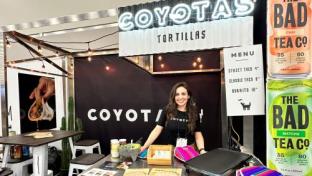Coffee and Tea Category Brews Up New Retail Trends
Late last year, Fresh Thyme Market rolled out a kiosk highlighting the premium loose teas of Tiesta Tea in all 71 of the food retailer’s stores across 10 states. Found in the bulk food section, the Tea-Osk offers a selection of black, green and herbal loose-leaf teas that can be purchased by the ounce, as well as a wide selection of tea infusers, loose-leaf teas in reusable tea canisters, and matcha green tea sourced directly from Japan.
“We’re constantly looking to expand our already vast selection of coffees and teas, which provide a depth of offerings for our customers,” says Robert Abdee, category manager of dry grocery and bulk foods at Downers Grove, Ill.-based Fresh Thyme, which is partly backed by Meijer. “Some of our newer additions I’m excited about provide a ‘farm to cup’ experience for the consumer as well as provide details of programs that give back to origin communities or donations to charities.”
[Read more: "Sprouts Farmers Market Pilots Boba Tea In-Store Concept in L.A."]
The partnership with Chicago-based Tiesta was inspired by the rise in popularity of loose teas, notes Abdee, adding that the program offers high-quality products “focused on flavor and function.”
Speaking of function, Abdee affirms that it’s currently all the rage in the coffee and tea space: “Adding functionality to various beverages has become a big trend in recent years. Being that coffee and tea are the two [most] consumed beverages worldwide, it’s only natural that this is the most efficient way to add additional functionality to a popular beverage that’s already part of a daily routine for many. It began with coffee brands such as Four Sigmatic, which set the benchmark for mushroom-based coffees, and has since expanded to other brands now offering additives such as fiber, prebiotics and probiotics. The growth continued, moving into the [ready-to-drink (RTD)] coffee [segment] next. Most recently, we have started seeing this trend also move into the tea category, [for both] bagged and RTD offerings.”
As for highlighting traceability for those consumers who “don’t just want a great-tasting coffee,” he observes, “Most craft roasters love to tell the story of where their coffee is from, if regenerative farming practices were used, or if the brand helps the origin farms by passing some of the proceeds back to the farmers or surrounding villages.”
Asked how Fresh Thyme promotes its coffee offerings in particular, Abdee replies: “The pandemic saw a rise in more people brewing coffee at home and experimenting with new ways to brew and love the coffee experience. Most of our new items are whole-bean varieties that are great for home brewing. To many, the perfect cup is an art form, and they need the best beans and the perfect roast ground and brewed at home to get that. To cover all the bases, we have made sure that we offer many brand options to cover any customer’s taste. These brands work closely with our in-house marketing and digital advertising team to help convey their brand’s story and values to the customer.”
Based on this heightened consumer interest and Fresh Thyme’s response to it, category sales are up almost 10% over last year at the grocer, according to Abdee. The tea category at Fresh Thyme is currently under review, with the retailer looking to add more items following the above trends.
‘A Tea for Everyone’
Sarah Segal, CEO and CBO of Montreal-based DAVIDsTEA, agrees that wellness is big right now in the tea category, also invoking the recent public-health crisis.
“As a result of the pandemic and its lockdowns, we saw a massive shift as consumers had the time to reflect inward, reprioritize their health and wellness, and seek healthier, functional beverage alternatives,” notes Segal. “But the demand isn’t simply for a healthier option — consumers want and deserve options that are convenient, fun, functional and flavor-forward — which is exactly where tea comes in. One of the best things about tea is the immense variety of what is available, from rare, premium single-origin teas to fun and funky herbal infusions, there truly is a tea for everyone, even if they don’t know it yet.”
This interest in health has spawned the sober-curious movement, which inspired DAVIDsTea to debut a collection of mocktail teas developed by its in-house tea mixologists. Its latest mocktail collection, which launched last December, included a Gin & Tonic variety, which Segal describes as “a tea that took years to perfect the unique blend and flavor profile: Multiple rounds of development and fine-tuning went into successfully recreating this classic cocktail’s flavor by blending lemon, coriander, juniper berries and green tea.”
Further, as consumer demand for immune health products surges, DAVIDsTEA continues to grow its line of teas featuring adaptogens — plants that are said to help the body cope with stress, anxiety and fatigue — which Segal calls “the new superfood of the decade.” In January, the company introduced two new tea blends containing adaptogens such as ashwagandha, reishi mushroom and chaga. “Our dedicated R&D team tirelessly researches and explores new flavor combinations that feature traditional ingredients and those at the forefront of health-and-wellness research,” she adds, noting that over the past three years, the company has “seen tremendous growth” in its sleep, cold and defense, and matcha categories.
In the realm of marketing and merchandising, DAVIDsTea’s approach “has always been putting the customer first,” asserts Segal. “This means having the mindset of the customer and meeting them where they are and where they shop.” As well as being carried at more than 3,800 grocery and pharmacy locations across Canada, with the goal of replicating this same success in the United States, the company maintains a store-in-store retail concept at leading Canadian drug store chain Rexall that “has proved successful in supporting customers in their tea journey, thanks to showcasing branded materials that allow learning and self-exploration,” according to Segal.
In Stores and Online
When it comes to coffee, healthy attributes are also uppermost, and once again, the pandemic played a key role in the adoption of better-for-you products.
“Over the years, we’ve seen an increasing demand for a combination of both flavor and wellness in consumer beverages and products,” affirms Kerry Sachs, president and CEO of High Point, N.C.-based Puroast Coffee. “We’ve seen this trend now transcend into coffee through several innovations of late, including mushroom- and keto-based coffee. As these remain popular, a rising potential within the coffee market is with low-acid coffee — a market that is intersecting [with] the very large coffee and antacid market trends.”
Billed as “the only low-acid coffee brand with published supporting scientific research and widescale grocery store distribution,” Puroast has experienced a sales boom “since the pandemic, as a result of expanded awareness through [our] rapidly growing — and COVID-driven — consumer presence on the web and corresponding online sales, mostly on Amazon,” explains Sachs. “Overall, the company has accelerated sales growth online, in grocery stores such as Kroger, at www.puroast.com and now in coffeehouses.”
As for how best to promote the company’s coffee, Sachs notes: “Optimum marketing is not surprisingly coming through digital marketing methods, [since] the consumer has actively increased [use of] the internet to research new and recommended products. [In another] post-COVID development, key retailers have redoubled their in-store merchandising, [which also aids] shelf performance for our products. Of late, new research shows Puroast to have seven times the antioxidants of green tea, [a fact that] we are now featuring.”
Buttered Coffee and Beyond
Upcoming areas of interest in the coffee and tea space abound. “From customers demanding more transparency about sourcing, to new flavor and product categories, we’re seeing quite a few trends that we’re excited by,” says Fresh Thyme’s Abdee.
These include:
Demand for Fair Trade and Rainforest Alliance Certifications: “We are continuing to see more focus on the people involved in the growing of coffee, with organizations like Fair Trade USA and Rainforest Alliance certifying many farms that meet the higher growing and farming standards,” he says. “These ultimately all help the planet and anyone associated with the growing, selling, trading and crafting of coffee.”
Coffee Supplements and Canned Beverages: “As more consumers find how easy it is to combine their daily regimens of coffee drinking and supplements, we’ll continue to see more growth in brands offering more additives such as immune support and health-boosting nutrients,” predicts Abdee. “The younger coffee consumers and members of Generation Z are known as big coffee lovers, with canned nitro and cold-brew drinks being some of the most popular [options].”
Buttered Coffee: “Alternative creamers and milks continue to remain popular, but we’re seeing other emerging trends, too, like buttered coffee,” he points out. “The idea is that by adding butter to black coffee, it enhances the caffeine to make it stronger and brings out the natural nutrients in the brew.”
Koji and Fermented Coffee Technique: “Mold is added to the green beans, and they are allowed to ferment for several days prior to roasting,” explains Abdee. “This process is said to make dark-roast [coffee] less bold and [to lower] acidity levels of light-roast beans.”
For her part, Segal admits to being “really interested in powdered teas like matcha and hojicha [roasted Japanese green tea]. We love their versatility and benefits! Since these are powdered, you are ingesting the full leaves and ingredients, so you are getting every last bit of nutrients the tea has to offer. This is an area in the industry we’ve been keeping a close eye on for a while as we continued to research and find ways to make [tea] more accessible when it comes to availability, price and flavor.”
Ultimately, though, the coffee and tea category is only a microcosm of the entire grocery offering. As Sachs observes, “There’s no question innovation continues not just in coffee and tea, but across the products spectrum — with those combining wellness and sustainability while ensuring excellent flavor faring exceedingly well.”
- Sustainable and Accessible
Two key goals for Montreal-based DAVIDsTEA are to ensure that people are able to find its products and that they understand the company’s commitment to eco-friendly packaging.
“It’s DAVIDsTEA’s mission to make tea accessible for everyone, and one of the ways we accomplish this is by ensuring our products are readily available in local communities where tea lovers do the majority of their everyday shopping,” notes CEO and CBO Sarah Segal.
“Our individually wrapped tea sachets with all-new compostable overwraps not only demonstrate that we continue to make the necessary investments in product development to grow the market for specialty teas and elevate our brand, but that we are dedicated to leading the tea industry by example when it comes to sustainability,” adds Segal. “Even though we specialize in loose-leaf tea, we make convenient packaging like single-serve formats for our matcha, and tea bags filled with loose-leaf tea, to reach a wider audience.”








